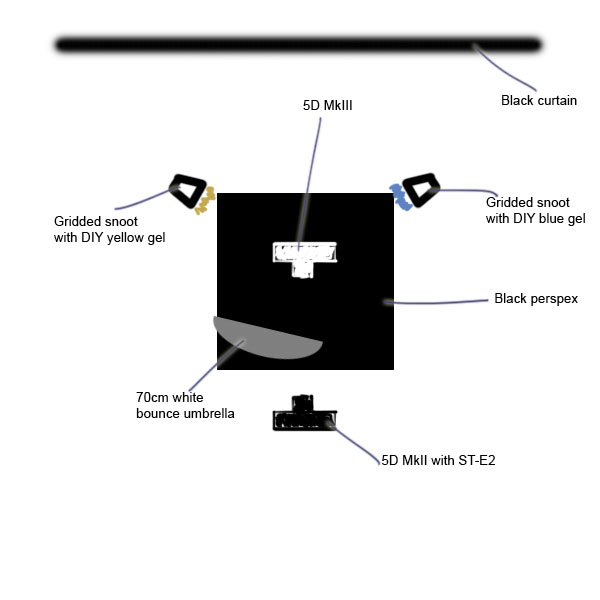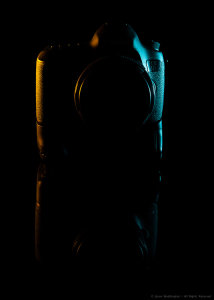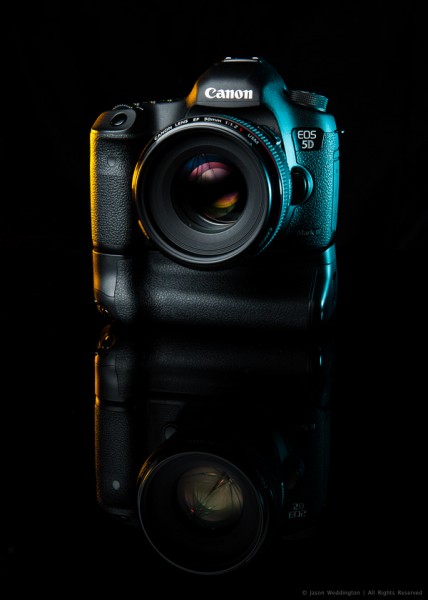In my last post, I talked about using a DIY blue gel to add interest to a portrait by lighting the background. This time I’ve added a DIY orange gel, and used the same Gary Fong Powersnoot for some product photography. This is a three-light setup.
Exposure: 1/200, f/14, ISO 100
Camera: Canon EOS 5D MkII
Lens: Canon EF24-70mm f/2.8L @ 60mm
When shooting a dark colored object against a dark background, one challenge is that the edges of the object tend to get lost in the background. Here are two ways to deal with this:
1. Light the background to add separation. This it the technique I used in my last post.
2. Use rim lighting to clearly define the edges of the object, as shown in the photo above.
The key to this kind of rim lighting is hard, directional light, so that the light goes exactly where you want it, and nowhere else. Good lighting is often about what not to light, as much as it is about what to light.
Set Diagram

Main Light: Canon 430EX II @ 1/2 power into 70cm white bounce umbrella just outside the frame to camera left
Rim Lights: 2 x Canon 430EX II @ 1/2 power into Gary Fong Powersnoots with grids a back left and right
I triggered the flashes with the Canon ST-E2.

Background: Black curtain about 1.5 meters behind the camera. The distance is important. If the background is too close, it will pick up some light from the main source and not appear totally black. Get your background cloth as far away as possible if you’re going for a pure black background.
The camera is sitting on a small square of black plexiglass (aka perspex) that I picked up at a local home improvement store.
Start With the Rim Light
To get the orange and blue highlights and the reflection right, I started with the gridded snoots. I shot a few frames and made small adjustments until I was happy with the look. Then I added the main light. It helps to build your lighting set up piece by piece.

Once I was happy with the rim lighting, I added the main flash, in the 70cm umbrella. Here I was looking for two things. First I wanted a nice catchlight on the lens. Second, I wanted enough light on the 5D logo on the top right side of the camera body. The umbrella is located just outside the frame on the left side, a little above, and angled down toward the 5D MkIII.
You don’t need a lot of space for a shot like this – I made this photo in my living room. The perspex is sitting on the coffee table, and the black curtain is draped over our TV.
I hope this article has given you a few useful ideas for lighting black objects against black backgrounds. I’d love you hear your comments, and as always, feel free to contact me on Facebook or Google+.
Post originally from: Digital Photography Tips.
Check out our more Photography Tips at Photography Tips for Beginners, Portrait Photography Tips and Wedding Photography Tips.
How to shoot Black Objects on Black Backgrounds
via Digital Photography School http://digital-photography-school.com/how-to-shoot-black-objects-on-black-backgrounds?utm_source=feedburner&utm_medium=feed&utm_campaign=Feed%3A+DigitalPhotographySchool+%28Digital+Photography+School%29

Your information has no comparison. It is very helpful for beginners. many many thanks sharing for your valuable tips. Best wish for you.
ResponEliminahow to remove clothing wrinkles in photoshop